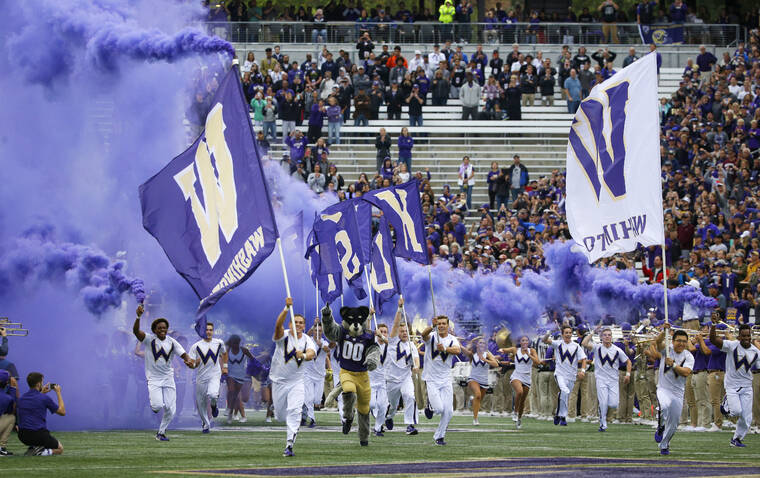
SEATTLE >> A day after leaving behind more than a century as a tenant to the premier athletic conference on the West Coast, Washington’s leadership said stability was at the forefront of its decision to join the Big Ten Conference.
“It was about having a future that we could count on and build toward,” Washington President Ana Mari Cauce said Saturday.
Cauce said there were several concerns that led to Washington and Oregon saying goodbye to their collective heritage to become the 17th and 18th members of the Big Ten beginning in 2024.
The Ducks and Huskies were two of the founding members of the Pacific Coast Conference in 1916 that eventually morphed into the Pac-12.
The decision by those founding members to leave in lockstep was the first of two crippling blows to the Pac-12 on Friday that left the conference on the precipice of collapse. Utah, Arizona and Arizona State accpeted offers from the Big 12 later Friday, following Colorado’s move late last month.
It leaves California, Stanford, Oregon State and Washington State as the four remaining members of the depleted Pac-12 for now.
At the heart of the Pac-12’s downfall was the failure to land a suitable media rights deal. Commissioner George Kliavkoff presented a deal with Apple to the conference members this week that fell short of expectations.
Cauce said the schools expected to have at least two offers to examine, but only one was presented.
Revenues from the Apple deal were not expected to approach the roughly $30 million per year Oregon and Washington will receive from the Big Ten for their first six years in the conference, with annual escalators and the ability to draw on future payments, a person familiar with the negotiations told the AP on Friday.
“There are a lot of forces at work including the overlords of the media empires that are out there that were driving a lot of this,” Arizona State President Michael Crow said Saturday. “And so the Colorado departure was really an indication of the fact that there was great instability in the media market and it created an unstable moment.”
Washington’s leadership declined to give specifics on the financials. Cauce said the ability to be on linear TV as part of the Big Ten’s media rights package was a factor in the decision and noted the offer presented by Kliavkoff included on opt-out after the first couple of years.
“It was backward and forward and there were moments when I thought it was going in one direction and then in another,” Cauce said. “At the end we looked at the deal that we had — the only deal that we had — and it was clear that it was not giving us what we thought. It was not the deal that we had been discussing just days before and it was not going to secure (us).”
Washington and Oregon will now play in a league where its closest opponent — minus Southern California and UCLA — is Nebraska, a drive of more than 1,600 miles. The Huskies and Ducks will be playing league games in all sports in State College, Pennsylvania; College Park, Maryland; and Bloomington, Indiana.
For Utah, Arizona and Arizona State, their decision to join the Big 12 could mean games in Morgantown, West Virginia; Orlando, Florida; and Cincinnati.
Some athletes outside of football took to social media after Friday’s wave of moves to express their frustrations about the impact of decisions that seem mostly related to football.
“The changes in the conference structure has been driven by money and at that altar of money, we have sacrificed academic integrity,” said retired Davidson coach Bob McKillop, speaking at Stephen Curry’s “Curry Camp” in Menlo Park, California on Saturday. “No one talks about that anymore. It’s as though academics are pushed to the sidelines and money is pushed on to the court. Continuity with your major, the stress of traveling across time zones multiple times, the travel inconveniences. It’s got to have an impact upon the academic success of our college students. It doesn’t seem to be a concern by a lot of people.”
Washington athletic director Jen Cohen acknowledged the increased travel will be a significant burden.
“I’ll be the first to say that this is not perfect,” Cohen said. “There will be challenges. This does require a lot of change and adaptability.”
While Arizona and Arizona State are moving conferences together and Utah’s move to the Big 12 reunites the Utes with BYU, the decisions by Washington and Oregon will end more than a century of almost continuous continuity with their in-state rivals.
Aside from a five-year span in the late 1950s/early 1960s, Oregon, Oregon State, Washington and Washington State have competed in the same conference dating to 1918.
Washington’s administration said its committed to keeping alive its Apple Cup meetings with Washington State in all sports in “nonconference competitions.” Oregon’s leadership said the same about the Ducks and Oregon State.
But those sentiments likely ring hollow with their rivals as the decisions by the Ducks and Huskies leave Washington State and Oregon State in an uncomfortable limbo.
“In the end, we had to do what was right. It is my responsibility to do what is right for our university, and our student athletes and athletic program that is truly special,” Cauce said. “The opportunities and stability offered by the Big Ten are simply unmatched.”
AP Sports Writers Janie McCauley and John Marshall contributed to this report.
Read More: World News | Entertainment News | Celeb News
Star Ads







